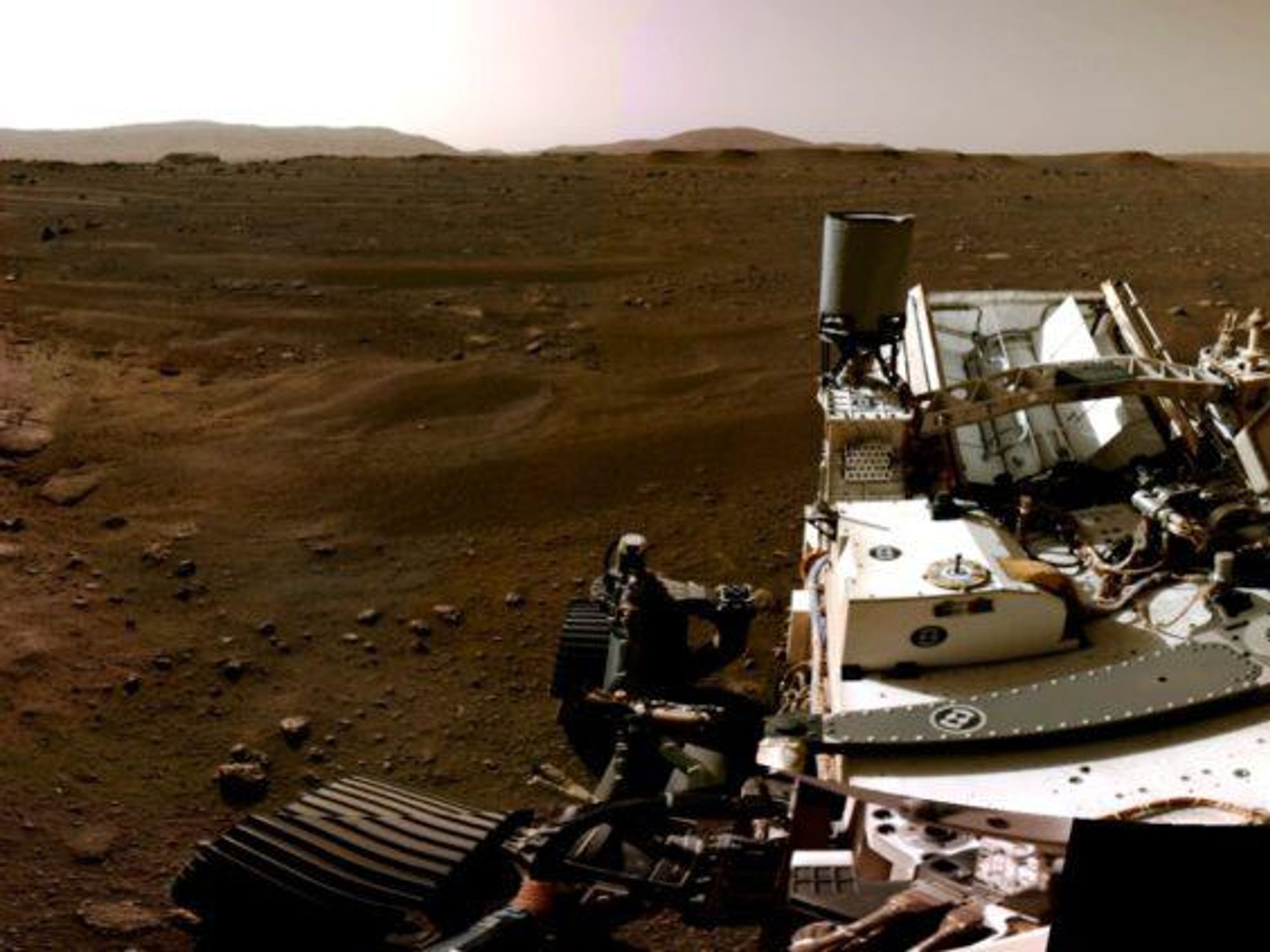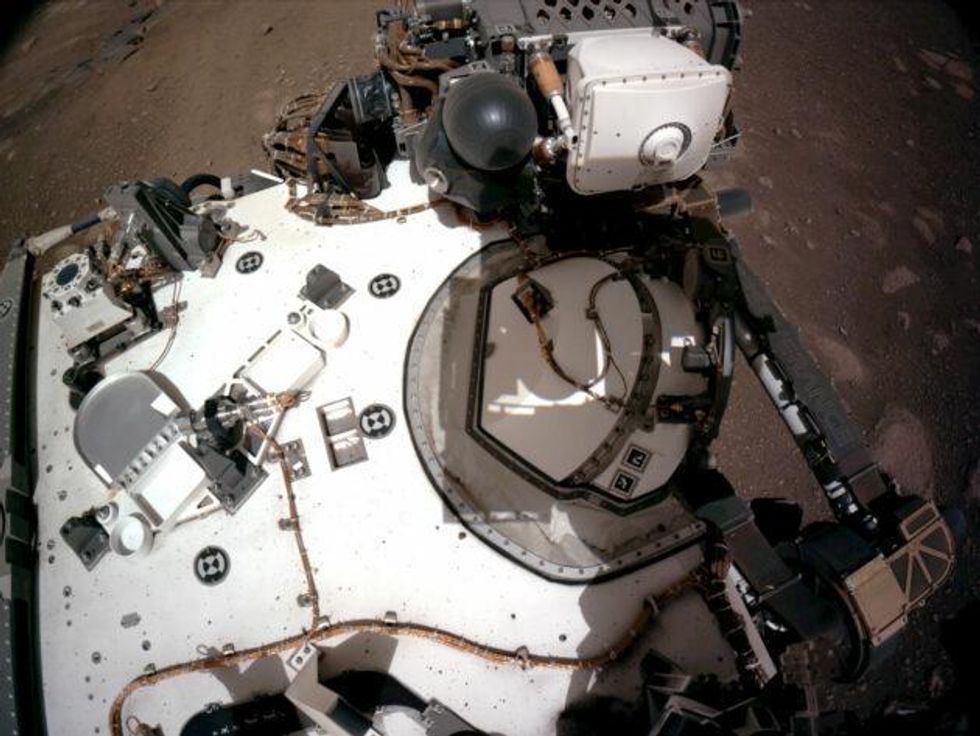NASA Releases Stunning Video, Audio from Mars
GeekWire contributing editor Alan Boyle is an award-winning science writer and veteran space reporter. Formerly of NBCNews.com, he is the author of "The Case for Pluto: How a Little Planet Made a Big Difference." Follow him via CosmicLog.com, on Twitter @b0yle, and on Facebook and MeWe.

For the first time ever, NASA has captured video of a rover landing on the surface of Mars, plus audio of the wind whistling past it after the landing.
The stars of the show are NASA's Perseverance rover and the hundreds of scientists and engineers supporting the mission to Mars at NASA's Jet Propulsion Laboratory and other institutions around the world. But Amazon Web Services is playing a key role in making all those gigabytes of goodness available to the world.
More than 23,000 images, amounting to 30 gigabytes of data, were gathered during the final minutes of Perseverance's journey to Jezero Crater on Mars, said Dave Gruel, camera suite lead for entry, descent and landing at JPL.
A couple of cameras looked up from the spacecraft's back shell to document the deployment of the parachute. Another camera looked down from the "Sky Crane" descent stage to watch the rover's touchdown. Meanwhile, cameras on the rover looked up at the Sky Crane and looked down and out to survey the surrounding terrain.
All those perspectives were put together in a three-minute video that documented the milestones of the descent, from the time the parachute popped open to the rover's dusty touchdown. At the end, video from the rover shows the descent stage flying away to its safe disposal, powered by a set of thrusters built by Aerojet Rocketdyne.
"It gives me goosebumps every time I see it," Gruel said at today's news briefing, conducted under COVID-19 conditions at JPL in Pasadena, Calif. "I hope everybody kept their hands and arms inside the vehicle at all times while it was in motion."
That's not all: A modified off-the-shelf microphone was hooked up to the rover, with the intention of recording the sounds of the air whistling past during the descent.
No sounds were recorded as the rover dropped, but once Perseverance had settled on its landing spot, the microphone captured the rumble of Martian wind gusts.
Gruel said the characteristics of the sounds suggest that the gusts were blowing at about 11 mph (5 meters per second).
As the mission proceeds, the microphone could capture the crunch of rocks beneath the rover's wheels as they roll, deputy project manager Matt Wallace said.
Both the video and the audio broke new ground for NASA: Although there's been descent imagery from past space odysseys, including the Apollo moon missions and the Mars Curiosity rover mission, this was the first time a video camera clearly captured the moment of touchdown on another planet.
As for the audio recordings, Soviet landers have previously recorded sounds on the surface of Venus, and NASA's Mars InSight lander has documented wind vibrations using an air pressure sensor. But Perseverance is the first to pick up the sounds of Martian winds directly with a microphone.
Thomas Zurbuchen, NASA's associate administrator for space science, said this is "how it feels to make history."
"The video of Perseverance's descent and landing, and the amazing panorama and the first wide landscape shot of Jezero Crater seen with human eyes, and the first Martian sounds are the closest you can get to landing on Mars without putting on a pressure suit," Zurbuchen said.
Releasing the raw images, video and the sounds should fire up the imagination — not only for future billion-dollar space missions, but for creative crowdsourcing here on Earth.
"Please go take a look at these data and play with them, especially those of you … that have signed up for our educational campaign," Zurbuchen said. "What can you find in these pictures? And who's going to compose the first piece of music with actual Mars sound?"
During the first couple of days of the mission, there was a fair amount of grumbling about the paucity of pictures released by the Perseverance team. But the situation changed dramatically today: The tally of raw images in NASA's Perseverance gallery jumped from less than 200 to close to 5,000 over the course of just a few hours.
Amazon Web Services said NASA is using its cloud computing platform to process image data from Mars, and to power NASA's Mars mission website. "The website will be able to scale up to meet demand at any given time, with millions of visitors expected at peak times," AWS said.

The plutonium-powered Perseverance probe is only four days into a mission that's expected to last at least two Earth years, and most likely much longer. The $2.7 billion mission's primary goal is to identify and store up samples that could hold evidence of past life on Mars. NASA plans to bring such samples back to Earth in about a decade for detailed lab study.
Leaders of Perseverance's science team say they're already seeing intriguing geological features to dig into, including an assortment of "holey" rocks that could be volcanic in origin.
"If they are volcanic rocks, that is enormously important to us, because it potentially provides an opportunity to get a really nice radiometric age, or an absolute date, if a sample like that comes back to Earth," deputy project scientist Ken Williford said.
This article first appeared on GeekWire.
- Moxie Mars Rover Will Produce Oxygen For Future Astronauts - dot.LA ›
- NASA Rover to Land on Mars With 3D Printed Parts - dot.LA ›
- How NASA Hopes to Build an Economy on the Moon and Mars - dot ... ›
- Perseverance rover begins quest to seek traces of life on Mars ›
- Octavia E. Butler, Sci-Fi Visionary, Is Memorialized on Mars - dot.LA ›
- Star Trek’s William Shatner To Board Blue Origin’s Spaceship ›
GeekWire contributing editor Alan Boyle is an award-winning science writer and veteran space reporter. Formerly of NBCNews.com, he is the author of "The Case for Pluto: How a Little Planet Made a Big Difference." Follow him via CosmicLog.com, on Twitter @b0yle, and on Facebook and MeWe.




